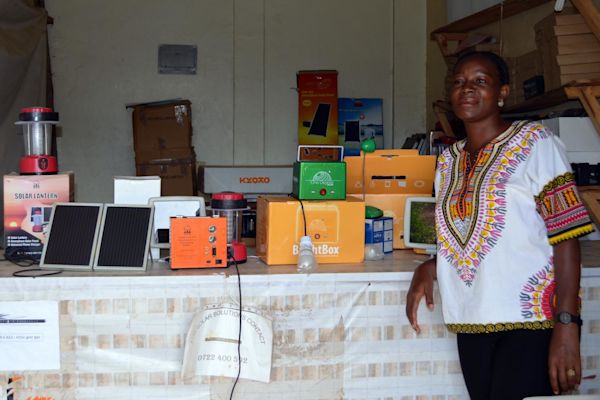Solar Solutions in Western Kenya - One Woman's Quest to Change Her Community
March 21, 2013
I met Eunice due to an emergency Kiva Fellows situation -- Liz, our incredibly talented media fellow needed to film a bee hive inspection at night, and we had no lights. Luckily, I noticed a ‘Solar Solutions’ shop across the street, we ran over to see what we could find. After a few minutes of chatting we discovered Eunice had a BrightBox fully charged and that she was willing to rent it to us for 500ksh. Our hive inspection went off without a hitch. And by ‘without a hitch’ I mean Liz got some gorgeous footage, the lights worked perfectly, and I only got stung twice by the African Killer bees that had worked their way inside my bee suit as I held the lights...
The morning after the hiveinspection saved by solar lighting, I wandered into Eunice’s shop to return the BrightBox that we had borrowed. Eunice proudly told me that she was the first and only solar shop in Kakamega, and she happily answered my barrage of questions that followed.
She opened her shop in 2010 and was happy that the business was finally starting to take off - she had just finished a large install for a new hotel in town that had decided to go mostly solar. She was also excited with the technological advances that had occurred in solar lighting in just three years. She brought me around to the back of her shop and showed me the monstrous panels she had purchased when she opened. Some as big as 5’x2’ which certainly weren’t an option for the myriad of farmers in the area that still used thatch for their roof. She happily showed me her newest model, the BrightBox I had rented from her. She noted her customers liked it as it was durable, the panel was small, but charged quickly and the light quality good.
I started to grill her on why she had gotten started with solar and what her challenges were. Eunice saw her job less as shopkeeper, and more as an educator. Getting the farmers to understand the benefits of solar was an uphill battle for her. Its not that Kenyans want to literally stay in the dark, they want a way to charge their ever-present mobile phone and lights for their children to study by, but they are just so used to the traditional way of going about this. Farmers save for years to get electricity - it costs 37,000ksh (about $400USD) to run a line to your house, more if the power company has to install poles. Its odd to travel through rural Kenya at night - the electrical poles are omnipresent, creating a quilt of power lines that criss-crosses the country side. And yet there are practically no lights to be seen under these poles as the vast majority of people are simply too poor to be able to afford this luxury that is transported right over their heads - so close and yet impossibly far. The BrightBox will sell for a far more affordable 8,000 - 10,000ksh, and this very well could be the mzungu price Eunice quoted me!
Eunice spends so much of her time educating people because she feels that rural Kenyans adopting solar technology is going to turn the country around. Its more than just looking to increase the market for her business, or ensuring her neighbor’s phone will be charged so she can use M-Pesa - she does it for the health of her community and the advancement of rural areas. Eunice noted to me that in the past decade she has seen more and more talented, smart young people from the countryside flee to Nairobi. These young men and women see the big bright city, with its flip-a-switch electricity and cyber cafes as the future. They are tired of how difficult and unadvanced their lives are without electricity: walking the few kilometers to a mobile charging duka and paying 25ksh to plug their phone in, their memories of studying by the flickering gaseous kerosene lantern for secondary school exams, and no Facebook or YouTube! Its a true brain drain - there is no one left here to work in the rural areas. Meanwhile Nairobi gets more polluted and crime-ridden as eager young people from rural Kenya pour in with a dream, only to wake up to the harsh reality of an overcrowded city with high unemployment rates.
Eunice gestured to the gorgeous countryside just past the corner, with its banana, palm and papaya trees. They simply aren’t willing to make a life for themselves here in the country, to use their energy and intelligence to make a difference in the community they were raised in. So I try and get the people to adopt solar, to make their lives better, to keep their children here. Its not just good for the environment, it will also create progressive ideas in our villages.
For Eunice, its more than just a solar light... it will change her community.
PREVIOUS ARTICLE
Does Kiva Have a Place in a Land of Wealth? →NEXT ARTICLE
Passport Series: Reaching refugees and other vulnerable communities in Lebanon →













